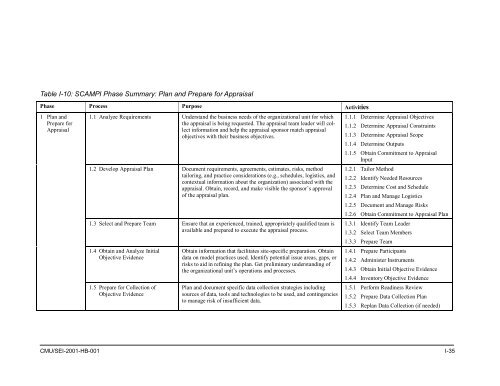Standard CMMI Appraisal Method for Process Improvement (SCAMPI)
Standard CMMI Appraisal Method for Process Improvement (SCAMPI)
Standard CMMI Appraisal Method for Process Improvement (SCAMPI)
You also want an ePaper? Increase the reach of your titles
YUMPU automatically turns print PDFs into web optimized ePapers that Google loves.
Table I-10: <strong>SCAMPI</strong> Phase Summary: Plan and Prepare <strong>for</strong> <strong>Appraisal</strong><br />
Phase <strong>Process</strong> Purpose Activities<br />
1 Plan and<br />
Prepare <strong>for</strong><br />
<strong>Appraisal</strong><br />
1.1 Analyze Requirements Understand the business needs of the organizational unit <strong>for</strong> which<br />
the appraisal is being requested. The appraisal team leader will collect<br />
in<strong>for</strong>mation and help the appraisal sponsor match appraisal<br />
objectives with their business objectives.<br />
1.2 Develop <strong>Appraisal</strong> Plan Document requirements, agreements, estimates, risks, method<br />
tailoring, and practice considerations (e.g., schedules, logistics, and<br />
contextual in<strong>for</strong>mation about the organization) associated with the<br />
appraisal. Obtain, record, and make visible the sponsor’s approval<br />
of the appraisal plan.<br />
1.3 Select and Prepare Team Ensure that an experienced, trained, appropriately qualified team is<br />
available and prepared to execute the appraisal process.<br />
1.4 Obtain and Analyze Initial<br />
Objective Evidence<br />
1.5 Prepare <strong>for</strong> Collection of<br />
Objective Evidence<br />
Obtain in<strong>for</strong>mation that facilitates site-specific preparation. Obtain<br />
data on model practices used. Identify potential issue areas, gaps, or<br />
risks to aid in refining the plan. Get preliminary understanding of<br />
the organizational unit’s operations and processes.<br />
Plan and document specific data collection strategies including<br />
sources of data, tools and technologies to be used, and contingencies<br />
to manage risk of insufficient data.<br />
1.1.1 Determine <strong>Appraisal</strong> Objectives<br />
1.1.2 Determine <strong>Appraisal</strong> Constraints<br />
1.1.3 Determine <strong>Appraisal</strong> Scope<br />
1.1.4 Determine Outputs<br />
1.1.5 Obtain Commitment to <strong>Appraisal</strong><br />
Input<br />
1.2.1 Tailor <strong>Method</strong><br />
1.2.2 Identify Needed Resources<br />
1.2.3 Determine Cost and Schedule<br />
1.2.4 Plan and Manage Logistics<br />
1.2.5 Document and Manage Risks<br />
1.2.6 Obtain Commitment to <strong>Appraisal</strong> Plan<br />
1.3.1 Identify Team Leader<br />
1.3.2 Select Team Members<br />
1.3.3 Prepare Team<br />
1.4.1 Prepare Participants<br />
1.4.2 Administer Instruments<br />
1.4.3 Obtain Initial Objective Evidence<br />
1.4.4 Inventory Objective Evidence<br />
1.5.1 Per<strong>for</strong>m Readiness Review<br />
1.5.2 Prepare Data Collection Plan<br />
1.5.3 Replan Data Collection (if needed)<br />
CMU/SEI-2001-HB-001 I-35
















